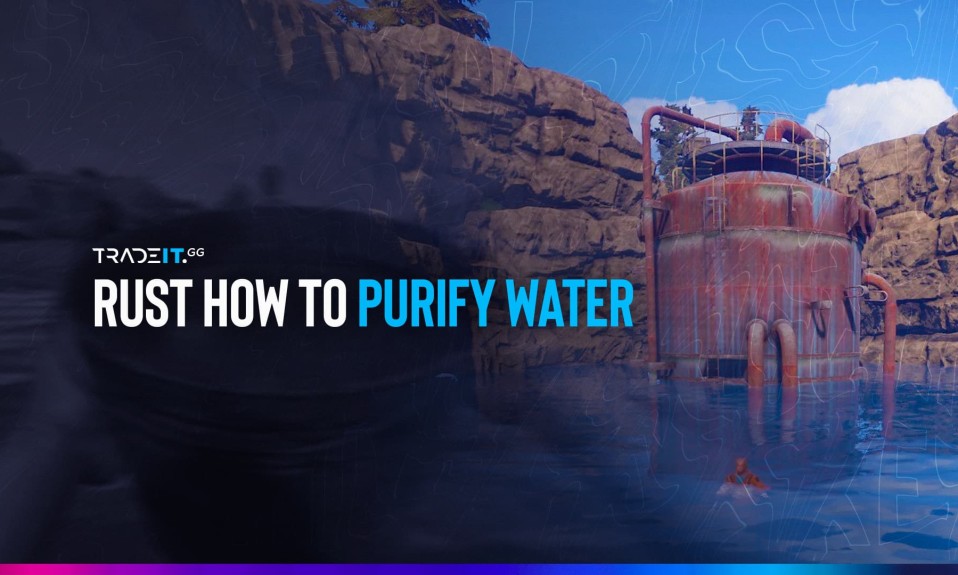
If you enjoy the multiplayer survival video game Rust, you already know that surviving is the most crucial objective. You must continue using resources in rust that are accessible in the woods alone because everything in this environment wants to kill you. One of the most important survival skills is ensuring you are hydrated, so you must know how to purify water in Rust.
The water purifier, a deployable utility item, is useful in this situation. This is made with recycled materials from your inventory intended to aid with saltwater filtration. But how does Rust’s water filter work?
Don’t be concerned if you’re unsure how to put it all up. This comprehensive Water Purifier Rust farm tutorial will show you the entire process in detail.
What Does Water Purifier Do Rust?
A water purifier in Rust cleanses salt water, as the name implies. To put it another way, the in-game purifier makes tainted water drinkable. Additionally, it will replenish your hydration. Additionally, drinking fresh water keeps you alive and healthy in both the game and real life.
In Rust, there are two different kinds of water purifiers:
- A basic water filter
- A powered water purifier
Early on, one will help you filter modest volumes of salt water; eventually, the other can help you automatically create large amounts of clean water.
In Rust, How to Purify Water?
For beginners, making a basic Water Purifier rust is the easiest way to purify water in Rust. Here is how to do it:
You will need to collect the following resources:
- 10 Cloth
- 15 metal shards
- One propane tank
Creating this water purifier will take 30 seconds once you have gathered all the required materials. First, you should be aware that this item has two inventories. Place the salt water inside the tank itself (or the input inventory) for proper use. The output inventory (or bucket) will then gradually fill up with clean and drinking water.
Powered Water Purifiers Farming
You will need the following resources for the powered purifier:
- Powered Water Purifier Blueprint
- 300 Metal Fragments
- 20 Cloth
- 100 Wood
- Workbench Level 2
With the Rust powdered water purifier, a portable filtering system is utilized to create drinking or farming water from ocean water. It does the same fundamental job as a water purifier, only on a much bigger scale.
Players will discover the typical Water In, Water Out, and Power In possibilities while checking available ports with a Wire or Hose Tool. It operates on 5 volts of electricity and is typically combined with a water pump for optimum effectiveness.
When energized, it converts salt water into fresh water and is accessible through the Water Out port for various purposes. Powered water purifiers are deployable on most surfaces and can be picked up when installed with a Hammer.
Powered water purifiers can be discovered in various low- to mid-tier crates and are frequently dropped by scientist types. For 150 Scrap, RUST players can buy them straight from Outpost, learn them through a research table, or spend scrap into the Tier 2 Workbench tech tree to learn them.
How long does it take to purify water?
In Rust, the procedure to purify the water begins immediately. Within a few minutes, a 2L water tank that is full will provide completely filtered water. In Rust, clean water that is safe to drink will be available to you quickly.
The work and time required to fill a bigger water tank may vary. When the water begins to flow, you can drink it right away. You don’t have to wait for the tank to fill up.
How do you get water with Water Catchers?
You can make Water Catchers collect rainfall and use it for hydration. These rust items are utilized so that you do not need to walk to a lake or river each time you become thirsty. Rust has two different sizes of water catchers: small and large. The starting point for the tiny catcher is one square, while the base for the large catcher is two squares.
The catchers’ main limitation is that they cannot be installed on cave walls, floors, or foundations. You will require 100 Wood, 50 Metal Fragments, a Trap, and other materials to make the Small Water Catcher. 500 Wood, 200 Metal Fragments, and 2 Traps are needed to make the Large Water Catcher.
The first takes 60 seconds, while the second takes 120 seconds. The Large Water Catcher can hold up to 50 litres of rainwater, while the Small Water Catcher has a 10-litre capacity.
How to Make a Big Water Catcher in Rust?
As you upgrade your camp, you’ll eventually run out of water, so prepare for that eventuality. While it’s acceptable to construct many Small Water Catchers, a larger one has five times the capacity and costs much less. The materials listed in the “How to Get a Water Catcher in Rust” can be used to make a Large Water Catcher.
You will, however, require a blueprint for this. Military/elite packages include the blueprint for the Large Water Catcher. Regular wood crates contain the Small Water Catcher blueprint.
How to Get a Water Bucket In Rust?
The Water Bucket is used to carry liquids, notably drinking water, from one location to another. It is reasonably easy to construct and has a 2-litre capacity. You need 20 Metal Fragments to make the Water Bucket item. Holding the right mouse button down near a body of water will fill the water bucket. You can use the bucket to store drinking water until you find a better option.
Final Words:
In this guide, we have explained how Rust players can save themselves from getting dehydrated. The first important thing is to get purified water, which you can easily achieve via water purifiers. After getting purified water, you may need some rust utilities to collect this purified water which includes water catchers and water buckets.
To meet all of your water needs, there are several other mechanisms. As you advance in the game, you’ll become more acquainted with the various mechanisms for providing you with fresh water.


